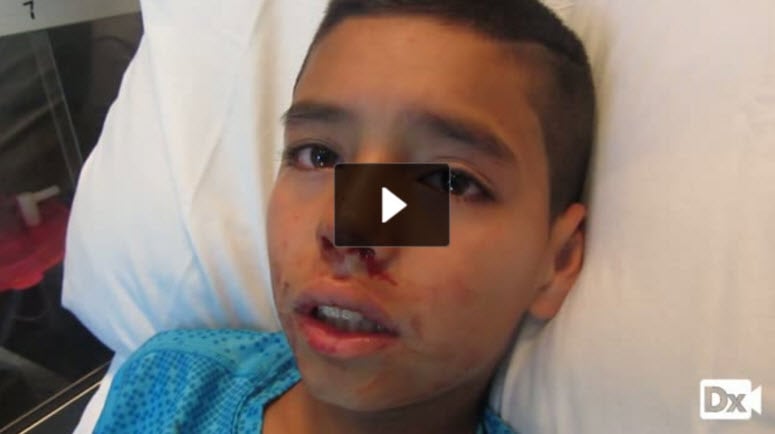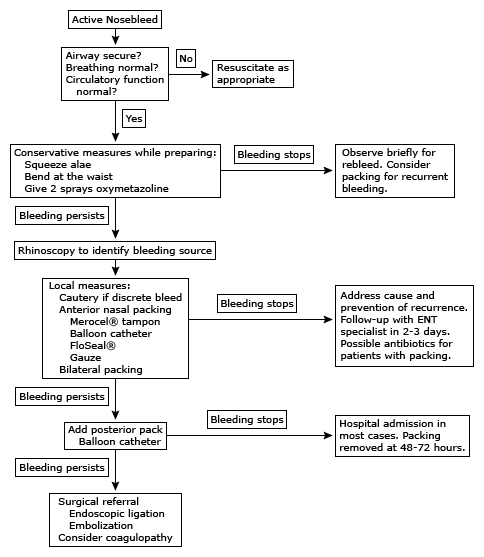
9-year-old with acute onset epistaxis and low platelet count
Patient will present as → a 14-year-old who is brought to your Emergency Department (ED) with an intractable nosebleed. Pinching of the nose has failed to stop the bleeding. In the ED, a topical vasoconstrictor is tried but also fails to stop the bleeding.
To watch this and all of Joe Gilboy PA-C's video lessons you must be a member. Members can log in here or join now.
Kiesselbach's Plexus or Little's Area is the most common site for anterior bleeds
- Woodruff's Plexus is the most common site for posterior nosebleeds
- The sphenopalatine artery is generally the source of severe posterior nosebleeds causing bleeding from both nares and posterior pharynx
- Patients should always be asked about aspirin or ibuprofen use

Image by Osmosis
The majority of patients do not require testing other than direct visualization
- Patients with symptoms or signs of a bleeding disorder and those with severe or recurrent epistaxis should have CBC, PT, and PTT.
- CT may be done if a foreign body, a tumor, or sinusitis is suspected.
Most nosebleeds are anterior and stop with direct pressure
- Apply direct pressure for at least 10-15 minutes, seated, leaning forward
- Short-acting topical decongestants (two sprays of oxymetazoline (Afrin), phenylephrine, cocaine)
- Anterior nasal packing
- Patients with nasal packing must be treated with antibiotics (cephalosporin) to prevent toxic shock syndrome, and the patient has to return to take the packing out
- If there is no packing in the nose, place a small amount of petroleum jelly or antibiotic ointment inside the nostril 2 times a day for 4–5 days
- Posterior balloon packing is used to treat posterior epistaxis. These patients must be admitted to the hospital, and prompt consultation with an otolaryngologist is indicated
- Recurrent epistaxis: Must rule out hypertension or coagulation disorder (like vWD)
Question 1 |
Remove the packing and insert a posterior balloon pack | |
Remove the packing and cauterize Kiesselbach's plexus Hint: This plexus is a common source of anterior bleeds. Since the bleeding is from a posterior source, cauterization here would be ineffective. | |
Replace the existing packing with Gelfoam packing Hint: While Gelfoam may be helpful, it won't achieve the tamponade pressure needed for a posterior bleed. | |
Apply a topical solution of lidocaine and epinephrine Hint: This topical solution can help with vasoconstriction but isn't sufficient for a significant posterior bleed. | |
Administer intranasal tranexamic acid (TXA) Hint: While TXA can be useful for epistaxis, a posterior bleed requires mechanical tamponade like a balloon pack. |
Question 2 |
Middle turbinate Hint: See D for explanation. | |
Posterior ethmoid artery Hint: See D for explanation. | |
Kiesselbach's triangle | |
Inferior turbinate Hint: The inferior turbinate is the most common location for posterior epistaxis. |
Question 3 |
A 7-year-old boy is brought to the clinic by his mother for recurrent nosebleeds over the past month. They usually occur spontaneously in the mornings but recently started happening 2-3 times per week. There is no history of trauma or recent illness. He's not on any medications. Which of the following is the most likely underlying cause of his recurrent epistaxis?
Nasal trauma from digital manipulation | |
Coagulation disorder (e.g., hemophilia) Hint: Bleeding disorders can manifest with nosebleeds but usually also with bleeding episodes elsewhere (bruising, post-dental bleeding, etc.). | |
Nasal foreign body Hint: Presence of foreign body may lead to a more isolated/unilateral type of bleeding and often has discharge symptoms as well. | |
Hypertension Hint: While rarely an initial presentation of hypertension in children, epistaxis can occur alongside a hypertensive crisis with extremely elevated blood pressure. | |
Juvenile nasopharyngeal angiofibroma
Hint: This benign vascular tumor occurs uncommonly, most notably in adolescent males, and characteristically bleeds on contact or with significant nasal obstruction symptoms. |
Question 4 |
A 65-year-old woman presents to the emergency department with a nosebleed that she has been unable to control for the past 45 minutes. She applied pressure and ice packs without success. Her medical history includes hypertension and chronic use of warfarin for atrial fibrillation. Following an initial attempt at anterior nasal pressure, the next step in managing this patient should be:
Topical oxymetazoline application Hint: A vasoconstrictor like oxymetazoline can help some milder bleeds but likely won't suffice alone with continued anticoagulation. | |
Cauterization with silver nitrate Hint: While potentially used for localized vessel sealing, it wouldn't fully address the impaired coagulation. | |
Anterior nasal packing Hint: Might be appropriate if bleeding primarily from anterior source and normal INR, but anticoagulation makes packing riskier (without reversal due to increased re-bleed potential). | |
Posterior nasal packing Hint: Used occasionally for significant epistaxis but in an anticoagulated patient (potential unknown INR elevation level), this carries extra risks for airway/bleeding. | |
Laboratory studies including International Normalized Ratio (INR) |
|
List |
References: Merck Manual · UpToDate


 Lecture
Lecture

